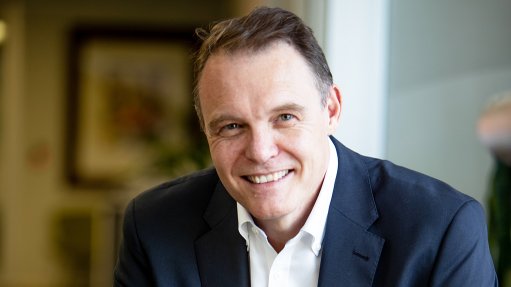Carbon Capture, Utilisation and Storage: A scientific intervention seeking to mitigate CO2 emissions while enabling the just transition
The economic impact of coal across South African communities cannot be underestimated, particularly when such an impact is investigated once coal has been fully discontinued. Close to a quarter of a million workers are employed in the coal industry, hence any discontinuation of this fossil fuel cannot be spoken of without considering the socio-economic impact.
The obvious reality is that climate change has become an urgent agenda item globally. The urgency has been necessitated by the entire world, in civil society, private and public sectors, as solutions are sought on how to address climate change. South Africa, like the rest of the world, is keen to play a leading role as we seek lasting solutions that protect our environment and reduce greenhouse carbon emissions. That is a journey.
Research institute Council for Geoscience (CGS), with over 111 years of geoscience knowledge and experience, continues to be fully committed to finding new technologies that will enhance environment-friendly energy sources. Sustainable solutions are needed though. One of these, currently considered globally as one of the key solutions, is Carbon Capture, Utilisation and Storage (CCUS). The CGS has embarked on a scientific intervention of CCUS that will see the sustenance of South Africa’s energy and national development needs, while equally contributing positively towards the transition from high to low carbon economy.
Globally, coal and oil have been widely relied upon as sources of hydrocarbons. South Africa is no exception. It is nearly 30 years since the United Nations Framework Convention on Climate Change (UNFCCC) was initiated and most member states are signatories. The UNFCCC called on members to act in the interest of their citizenry and humanity at large.
Scientists, appreciative of the role played by coal, have identified the problem and admitted how complicated it is. It is not an easy solve. Solutions must be found as we move to a low carbon economy and science must form the basis of such.
One of these solutions is CCUS. This is a solution inspired, among many other benefits, by the identification of carbon dioxide (CO2) as a greenhouse gas (GHG) that has become central to global warming.
Advances in CCUS technology globally, including in countries like the US, Norway and Canada have proven the technology to be a feasible alternative to reducing CO2 emissions through utilisation and underground storage in suitable geological formations. Once underground, the CO2 interacts with the geological environment and mineralises, which reduces the risks associated with leakage.
CCUS intends to capture CO2 from the source such as the coal fired power plants and transport it to carefully selected geological sites for permanent storage, which is supported by extensive monitoring, pre-, during and post-injection and storage.
The CGS has recently started with geological characterisation of an identified potential site in Leandra, in the Govan Mbeki Local Municipality in Mpumalanga, where consultations with a myriad of stakeholders including three government spheres, local traditional leaders, communities, environmental non-government organisations (NGOs), farmers and local businesses have borne fruit, mostly with the long-term goal of seeing the community benefit from this development. The Govan Mbeki Local Municipality has contributed a piece of land for this research to be implemented. The identified site has taken into consideration all factors such as location, geology, socio-economic and technological aspects to make a pilot feasible, thus a site proximal to CO2 emitters.
Mpumalanga is South Africa’s coal capital, making the province an energy hub. Hence, the current coal plants cannot be merely decommissioned without taking into cognisance the implications of such an action.
The two-pronged approach aims to raise awareness among South Africans about CCUS technology. The technology is encouraging, though we need to be mindful that it may take time before we see the commercial benefits and return on investment.
The models that have worked in countries such as the US, cannot be readily assumed to also work in South Africa. Hence, the CGS and other scientists are investing time and effort in extensive technological feasibility studies and technological disruptions, particularly adaptable to sites in South Africa, both on and off-shore.
South Africa has pledged to cut CO2 emissions by 50% by 2030, which is six years from now. Acknowledging the significance and abundance of coal, it is crucial to explore practical approaches to meet this goal and effectively address emissions stemming from hydrocarbons like coal to enable the country to transition justly to a low GHG economic development trajectory in conjunction with other energy sources such as renewables and nuclear.
The truth about coal is that it is affordable. There are enough coal companies in South Africa employing tens of thousands of people, albeit financing development of coal projects has become increasingly challenging while the financing institutions investigate how best to contribute towards the reduction of greenhouse emissions. Technologies need to be applied on how best to use coal as we transition towards a low carbon economy. The big question is whether this just transition can be done sustainably, justly and justifiably?
Once we have figured out this reduction intervention, such a breakthrough will not only benefit power utility Eskom, communities and business, but it will go a long way in the commitment we have made when it comes to CO2 emissions. As Eskom unbundles into three divisions, we hope these will be synced to address this long-standing problem as Eskom continues to operationally rely on coal.
The technology associated with CCUS is centrally developed as an economic contributor that aims to do better and contribute generously towards the country’s gross domestic product. In this regard, the South African government assigned the CGS as an implementing agent for the CCUS research in partnership with the World Bank. The CGS has further developed a network of private business partnerships that include finance institution the Development Bank of Southern Africa (DBSA), energy company Sasol and resources company Exxaro, while others are still in the pipeline for finalisation. With such partners, this intervention is guaranteed to benefit from collective wisdom, resource crowding and accelerated implementation of ideas and technological applications.
The CCUS project has underlined how pivotal South Africa’s commitment to reducing GHG emissions is. The project directly responds to government’s call that innovative solutions are sought for a transition to a low carbon economy.
It is a question that cannot be brushed aside, one that a project such as CCUS aims to answer as it undertakes to be part of the solution. While the journey of this project can be traced back to Leandra, the ultimate benefit will be enjoyed by the entire country. Moreover, it has been proven from other parts of the world that CCUS could be a viable option – our aim though, is to not only copy from the work that has already begun in other parts of the world, but endeavour to deliver a project that takes into account our diverse geology, unique environment and overall technical excellence of our South African institutions.
Article Enquiry
Email Article
Save Article
Feedback
To advertise email advertising@creamermedia.co.za or click here
Comments
Press Office
Announcements
What's On
Subscribe to improve your user experience...
Option 1 (equivalent of R125 a month):
Receive a weekly copy of Creamer Media's Engineering News & Mining Weekly magazine
(print copy for those in South Africa and e-magazine for those outside of South Africa)
Receive daily email newsletters
Access to full search results
Access archive of magazine back copies
Access to Projects in Progress
Access to ONE Research Report of your choice in PDF format
Option 2 (equivalent of R375 a month):
All benefits from Option 1
PLUS
Access to Creamer Media's Research Channel Africa for ALL Research Reports, in PDF format, on various industrial and mining sectors
including Electricity; Water; Energy Transition; Hydrogen; Roads, Rail and Ports; Coal; Gold; Platinum; Battery Metals; etc.
Already a subscriber?
Forgotten your password?
Receive weekly copy of Creamer Media's Engineering News & Mining Weekly magazine (print copy for those in South Africa and e-magazine for those outside of South Africa)
➕
Recieve daily email newsletters
➕
Access to full search results
➕
Access archive of magazine back copies
➕
Access to Projects in Progress
➕
Access to ONE Research Report of your choice in PDF format
RESEARCH CHANNEL AFRICA
R4500 (equivalent of R375 a month)
SUBSCRIBEAll benefits from Option 1
➕
Access to Creamer Media's Research Channel Africa for ALL Research Reports on various industrial and mining sectors, in PDF format, including on:
Electricity
➕
Water
➕
Energy Transition
➕
Hydrogen
➕
Roads, Rail and Ports
➕
Coal
➕
Gold
➕
Platinum
➕
Battery Metals
➕
etc.
Receive all benefits from Option 1 or Option 2 delivered to numerous people at your company
➕
Multiple User names and Passwords for simultaneous log-ins
➕
Intranet integration access to all in your organisation





















